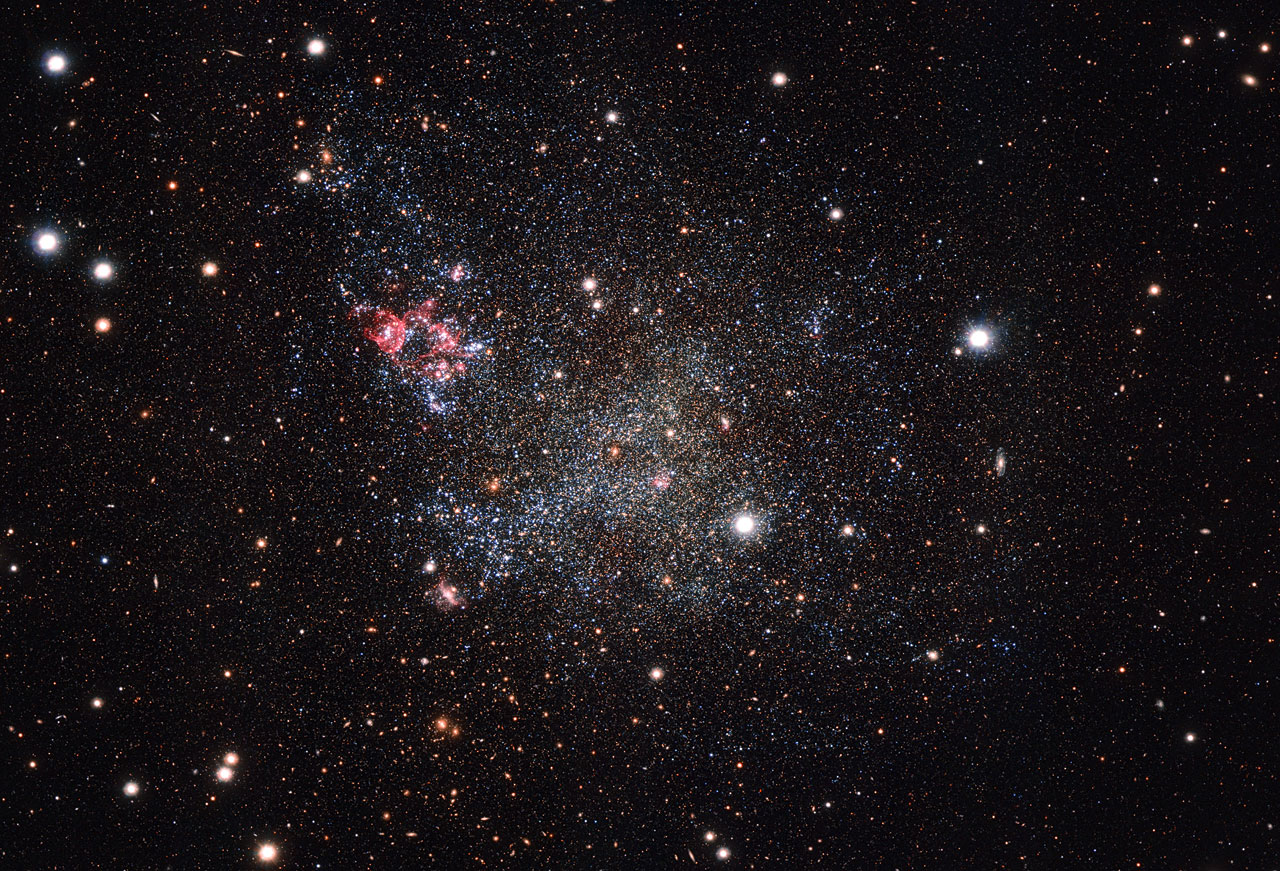'Clean Freak' Galaxy Shines in New View (Video)

A small, nearby galaxy boasts very little cosmic dust, making it easier for telescopes to capture an incredible new image of its "squeaky clean" expanse.
The dwarf galaxy IC 1613's lack of dust allowed the European Southern Observatory's (ESO) Very Large Telescope in Chile to get an extra-sharp picture of the galaxy, which ESO officials have dubbed a "clean freak." ESO scientists created a video that zooms in on the squeaky clean galaxy.
Like the Milky Way, IC 1613 is part of the Local Group, a collection of more than 50 galaxies near our own. IC 1613 is about 2.3 million light-years from Earth, making it "close," in the cosmic sense. Because it's so near, it's been studied frequently. Astronomers previously discovered that it is an irregular dwarf galaxy that doesn't have certain features, such as a starry disc, found in similar galaxies. [Photos: 65 All-Time Great Galaxy Hits]
"However, what IC 1613 lacks in form, it makes up for in tidiness," ESO officials said in a statement. "We know IC 1613's distance to a remarkably high precision, partly due to the unusually low levels of dust lying both within the galaxy and along the line of sight from the Milky Way — something that enables much clearer observations."
Estimating distances is even easier for IC 1613 because it is embedded with two kinds of variable stars, called Cepheid variables and RR Lyrae variables. These stars pulse in a predictable way, allowing astronomers to estimate the distance based on the pulsars' brightness. Astronomers dub these kinds of stars "standard candles" because they act as convenient measuring sticks to better evaluate the size of the universe.
"Using standard candles — such as the variable stars within IC 1613 and the less-common Type Ia supernova explosions, which can [be] seen across far greater cosmic distances — astronomers have pieced together a cosmic distance ladder, reaching deeper and deeper into space," ESO officials said in the statement.
IC 1613 was discovered in 1906 by German astronomer Max Wolf, and was studied in more detail by Walter Baade at Mount Wilson Observatory in California in 1928. Baade's work showed astronomers that the galaxy must be very close, as its individual stars showed up like pinpricks in his telescope. This would only be possible if IC 1613 was near Earth, he suggested.
Get the Space.com Newsletter
Breaking space news, the latest updates on rocket launches, skywatching events and more!
Follow Elizabeth Howell @howellspace, or Space.com @Spacedotcom. We're also on Facebook and Google+. Original article on Space.com.
Join our Space Forums to keep talking space on the latest missions, night sky and more! And if you have a news tip, correction or comment, let us know at: community@space.com.

Elizabeth Howell (she/her), Ph.D., is a staff writer in the spaceflight channel since 2022 covering diversity, education and gaming as well. She was contributing writer for Space.com for 10 years before joining full-time. Elizabeth's reporting includes multiple exclusives with the White House and Office of the Vice-President of the United States, an exclusive conversation with aspiring space tourist (and NSYNC bassist) Lance Bass, speaking several times with the International Space Station, witnessing five human spaceflight launches on two continents, flying parabolic, working inside a spacesuit, and participating in a simulated Mars mission. Her latest book, "Why Am I Taller?", is co-written with astronaut Dave Williams. Elizabeth holds a Ph.D. and M.Sc. in Space Studies from the University of North Dakota, a Bachelor of Journalism from Canada's Carleton University and a Bachelor of History from Canada's Athabasca University. Elizabeth is also a post-secondary instructor in communications and science at several institutions since 2015; her experience includes developing and teaching an astronomy course at Canada's Algonquin College (with Indigenous content as well) to more than 1,000 students since 2020. Elizabeth first got interested in space after watching the movie Apollo 13 in 1996, and still wants to be an astronaut someday. Mastodon: https://qoto.org/@howellspace